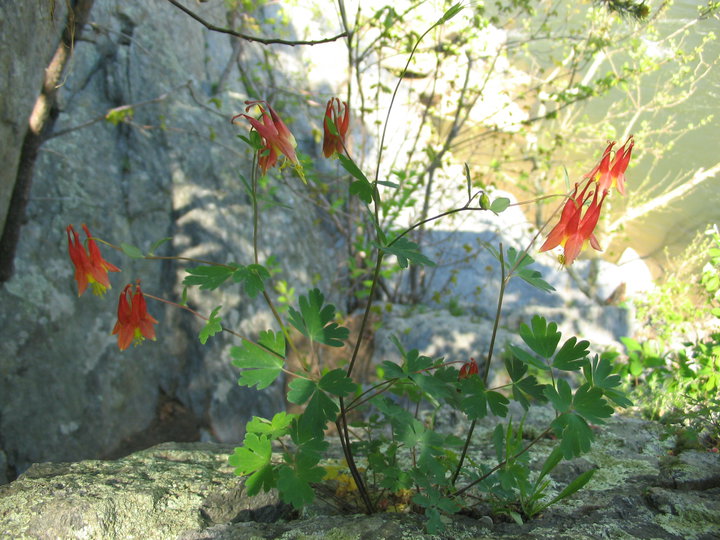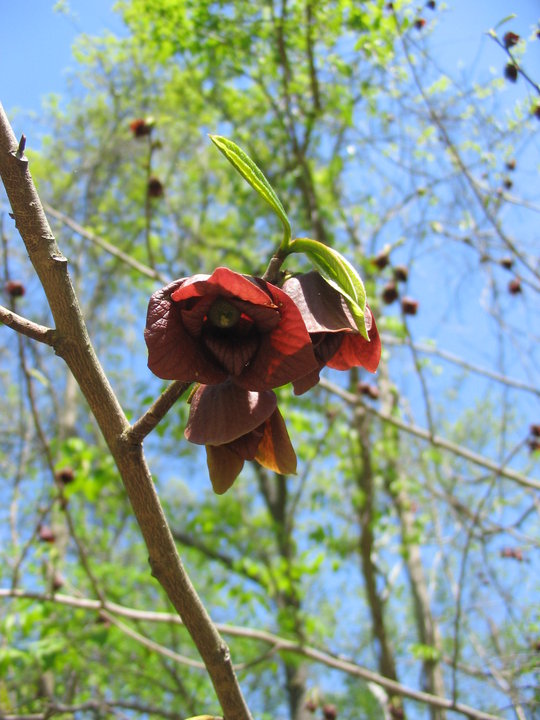A Walk on the Wild Side – Part 1
An Explorer’s Journal of Native Plants in the Landscape
Great Falls National Park – Part 1 – April 15, 2010
Great Falls National Park – Part 2 – May 1,2010
It’s so exhilarating to see native plants in the wild! So many natives are featured in articles and books, but to see them in situ is to truly appreciate them as living, breathing members of the ecosystem. Today’s weather was perfect for exploring the wilderness, so I headed to one of my favorites, Great Falls National Park.

The Virginia side has a trail along the rocks called the River Trail, and here I have had many unexpected discoveries and delights. Observing where plants are growing in the wild gives you a great sense of what conditions they prefer to grow in, and after a while, you can also predict where you might find more.
This was my first visit to the park since the flood from the snowmelt and rain of this past winter, and you can clearly see how high the water rose…there are clumps of debris still sitting like misshapen bird nests in the shrub branches growing along the top of the rise along the river. Water must have rushed by along the whole gorge, totally covering the places I found so many natives…and they all seem fine! Amazing.

Nestled in the crevices between rocks were Wild Columbine (Aquilegia canadensis), Coral Bells (Heuchera americana), Catchfly (Silene), Moss Phlox (Phlox subulata), Bird’s-Foot Violet (Viola pedata), Mountain Laurel (Kalmia latifolia), Pinxsterbloom Azalea (Rhododendron periclymenoides), Eastern Ninebark (Physocarpos opulifolius) and oodles upon oodles of Lowbush Blueberry (Vaccinium angustifolium). I don’t think I’ve ever seen more blueberries, and let me tell you, they wedge themselves into the tightest of rock crevices.
My favorite discovery had to be the Bluets (Houstonia caerulea) dotting the gritty soils along the path itself, sometimes growing amidst a patch of moss. Upon seeing my first one, I had a moment of “They do exist!” and then, “Wow, they’re tiny!” The clump of leaves could fit on a half-dollar coin. It’s easy to see how all of these were plants truly must appreciate sharp drainage and tolerate the exposure to sun and wind of cliff-side living…especially when you have to scramble down a few rocks just to take their picture.

In the wooded area further back from the river, Woodland Phlox (Phlox subulata and divaricata) were blooming in a mix of hues from lavender-blue to blue-violet to near-white. Virginia Bluebells (Mertensia virginica) were finishing flowering, but their luscious leaves were easy to spot. The same was true for the Dutchman’s Breeches (Dicentra cucullaria), a relative of Bleeding-heart with fine lacy foliage. I may have even found a couple Twinleaf (Jeffersonia diphylla), but I’ll have to do some homework in plant identification to be sure as they weren’t in flower.

I also saw a lone Wild Ginger (Asarum canadense). Various ferns were still unfurling – Christmas (Polystichum acrostichoides), Lady (Athyrium felix-femina) and even a couple Maidenhair (Adiantum pedatum).
I saw the occasional Trillium (Trillium sp.) (another gasp at that) and Bloodroot (Sanguinaria canadensis), though other ephemerals like Spring Beauty (Claytonia virginica) were everywhere.
Even Pawpaw (Asimina triloba) was plentiful in the woods, with seemingly every tree loaded with those characteristic dark maroon flowers. I spotted a few Zebra Swallowtails flying around laying eggs, as Pawpaw is their sole caterpillar food source.
I’m looking forward to what I’ll find next time!

I enjoyed your article and am thrilled to have someone writing about our native plants in their natural areas. I have just been to Carderock and saw American ginger, woodland phlox, meadowrue, blue cohosh, ragwort, and many other beauties! One comment, the second picture is of a Birdsfoot violet, Viola pedata, I believe. You have it listed as a Mertensia. Thanks for writing this article and please keep it up.
Wow – good catch. You are absolutely right. Looks like I messed up with the caption description. The article was written by Miri T and I uploaded it for her. Im sure she will follow up with a comment soon. Also look for more articles from her very soon.
This is so wonderful for those of us unable to get out in time to catch the brief Spring show! Thanks especailly for the details (ie “lowbush found in crevices”, etc)
Please keep posting when you can – I’d be especially interested to know what’s going on in late May – June with our natives.